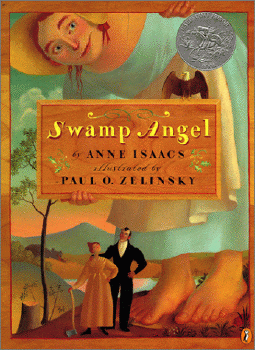
BIBLIOGRAPHY
Isaacs,
Anne. 1994. SWAMP ANGEL. Ill. by Paul O. Zelinsky. New York: Puffin Books. ISBN
0-14-055908-6
PLOT
SUMMARY
When Angelica
Longrider was born in 1815, she certainly made a BIG impression. At birth, she
was taller than her ma. By the time she
was twelve, Angelica (lovingly known as Swamp Angel) towered over all those
around her. One summer the residents of Tennessee
were being terrorized by a bear. Swamp Angel sets out to defeat Thundering
Tarnation, the giant bear who ate all of the settlers’ food and was too wily to
be caught. Tarnation and Angel battled
on and on, through day and even in their sleep. In this way, the tall tale
explains why the Great Smoky Mountains were named so and how Ursa Major ended
up in the starry night sky.
CRITICAL
ANALYSIS
This is
a great read aloud book for older children. The story uses a lot of “down home
drawl” and the phrases from 1800s Americana.
In fact, a working knowledge of dialects (such as the typical Tennessee
drawl) would add a lot to the understanding of this book. The beautiful oil paint pictures add to the
story. It is no wonder why SWAMP ANGEL is a Caldecott Honor Book. There is movement and action within the illustrations. They are done in
the traditional early-American style, thus adding to the time period being
represented in the story. Reading the
story with an accent can add to the fast-paced, humorous story. Overall, the exaggerated story and beautiful
pictures leave an impression on readers, both young and old.
REVIEW EXCERPTS
PUBLISHERS
WEEKLY review: “This valiant
heroine is certain to leave youngsters chuckling-and perhaps even keeping a
close watch on the night sky.”
SCHOOL
LIBRARY JOURNAL: “It's an American classic in the making.”
CONNECTIONS
There
are many tall tales that can be read in conjunction with Swamp Angel. A great way to
explain legendary American tall tales is through these picture books:
Blair, Eric. PAUL
BUNYAN: A RETELLING OF THE CLASSIC TALL TALE. Ill. by Micah Chambers-Goldberg.
ISBN 1-4048-0976-7.
Glass,
Andrew. FOLKS CALL ME APPLESEED JOHN.
ISBN 0385320450
Kellogg,
Steven. SALLY ANN THUNDER ANN WHIRLWIND CROCKETT. ISBN 9780688171131
And, of
course, readers must know what happened to Angelica when she moved to Montana:
Isaacs,
Anne. DUST DEVIL. ISBN 0375867228




